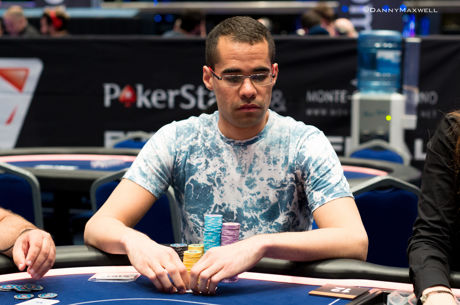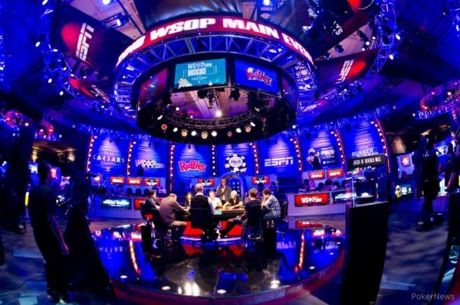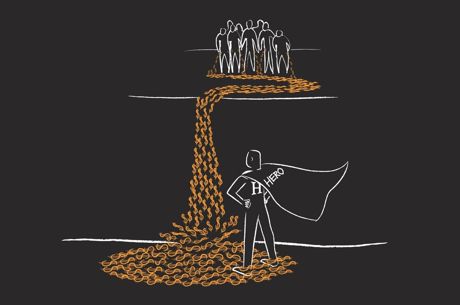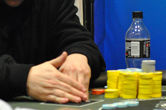Learning to Think About Your Own Range of Hands, Part 2
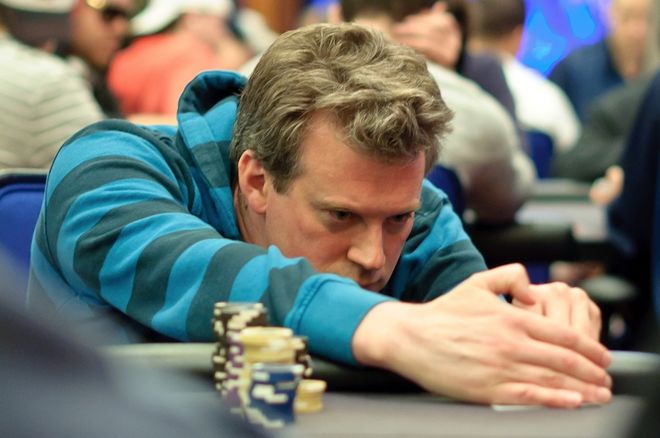
Last week I began to describe a hand that offered a good chance to talk about how to think about your own range of hands (as opposed to your opponent's range). Let's recap...
I had gone to beautiful Killarney, Ireland to play a poker tournament, the recent World Poker Tour National event. Before we'd reached the money I had a stack of 19 big blinds when I open-raised 2x from the button with AxQx-offsuit. I was called by the big blind (who had me covered).
We both checked a 10x9x8x flop, then saw an offsuit 2x turn. My opponent bet 60% of the pot (2.5 big blinds), and I called.
The river card? An offsuit Jx, making the board 10x9x8x2xJx. My opponent checked.
I decided to bet small. With those hands we want to bet, we should bet small because we have very few bluffs on this board. Again, let's focus on our own range here.
What calls the turn that wants to bluff this river? Kx8x? 8x6x? While there are some hands that can choose to bluff, most non-QxXx hands in my range will just want to check and take a showdown. On the other hand, we can have all sorts of QxXx and 7xXx hands as well.
I bet just under two big blinds into the pot of 11 BBs. Our opponent then check-raised enough to put me all in for my last 12 big blinds.
Easy call, right? Or is it?
Looking for clues in our own range (continued)
Well, when we consider that our opponent would have (or should have) three-bet KxQx before the flop (remember, effective stacks to start the hand were 19 BBs), then yes, the call is easy. But this was live poker and not everyone plays "standard" preflop. Let's look at the case where our opponent has KxQx in his preflop range.
In this river situation, the density of straights my turn-calling range makes on this particular card is high enough to create a bit of a dilemma when our opponent takes the strongest lines. The top of my range is very large. If we define it as QxXx and better, then I have...
- 16 combinations of KxQx
- 16 of AxQx
- 12 of QxJx
- 12 of Qx10x
- 12 of Qx9x
- 12 of Qx8x
- 16 of Qx7x
We can add as well six combinations of QxQx and four of Qx6x-suited (I fold Qx5x and worse to the turn bet). That adds up to a range including 106 combos of hands.
At least two things follow from this examination of our own range.
First, it is suicidal for the big blind to bluff against a betting range that includes 106 combinations of QxXx or better straights. (So should we really be calling to chop, then?)
Second, if I fold all my bare QxXx hands, I am folding too much of the top of my range, from an exploitative perspective. But if I fold none of my QxXx hands, I am not folding often enough.
We could call these 106 combinations the "clue range" �� the set of hands equal in strength to my hand that, when counted, guides our play.
When we realize our "clue range" is large, we should be able to fold some amount of it to an opponent's strongest lines (and to the worst prices he can lay us). But if we figure out the "clue range" is small, then we should consider our hand ��too far up our range to fold�� (as the kids say these days).
What hands in our range can we fold?
We have 16 combinations of KxQx that we're never folding, but how can we determine which QxXx hands to fold in this situation? Don't they all look more or less the same?
Well, if we call all 90 remaining combinations, we are calling too much relative to our price. If we fold all 90, my opponent should check-raise all in every time on this river with any bluff candidate, because we will be folding too often.
I think we actually shouldn't be value betting 7xXx too often here. But let's say we value bet Kx7x only (as it blocks KxQx), then bluff in equal proportion to our bet size. We laid our opponent 7-to-1, so we should have one bluff for every seven value bets. Because we have about 122 value bets, we should have about 17 bluffs.
Then our opponent moves all in, laying us 12 big blinds to win 27.5 big blinds. If we are playing at an equilibrium, we should call 69.6% of the time. If we look back at our betting range, we can take our 139 betting combinations and multiply it by 0.696 = 98. So we should call 98 combinations and fold 41. That means folding 17 bluffs and 16 combinations of Kx7x and 8 combinations of QxXx. So indeed, we have to fold some QxXx.
The math shakes out similarly if we check back all 7xXx as I suspect we should. Then we are bluffing 15 combinations and therefore betting 121, and thus need to call 84 combinations. If we fold our 15 bluffs, we have to come up with a whopping 22 combinations of QxXx with which to fold the river. Because we have 90 combinations of QxXx that aren't KxQx, this is basically 25% of our QxXx hands we are folding to the check-raise!
I think Qx8x and Qx9x are good hands to call with because they block the hands our opponent is most likely turning into bluffs. Meanwhile Qx7x is a good hand to fold because it doesn't block those hands whatsoever.
I also think QxJx is probably a great hand to fold among the remaining QxXx hands because we had a stronger hand with QxJx on an earlier street than all the other combinations. Poker players sometimes suffer from what I call ��acting upon residual value.�� They had a pair and a flush draw on the turn, so they overvalue said pair on the river when the draw missed, all other things equal.
In training ourselves to improve, we should invert this natural tendency. The pair and the flush draw on the turn should be our first priority to fold on the river, if we can call with the ones that didn't have the draw. Here, if we have to fold some QxXx hands but not nearly all of them, then we should decide to fold the QxXx that was strongest on previous streets. QxJx also blocks our opponent's calling range and doesn't block bluffs �� JxXx being the least likely hand for him to raise of all hands.
What actually happened
You probably already guessed what actually happened. I called with my AxQx, reasoning my opponent would have three-bet KxQx preflop. And I promptly got shown KxQx. Then I left the tournament room.
It was surprising for me to count just how many combinations of QxXx I should have in this river spot. When taken in tandem with the fact that I have KxQx in my river betting range as well, I think it is indeed suicidal for my opponent to try and bluff this situation in practice (though he can in theory).
Therefore, we should give some pause and consideration to bet-folding the second nuts �� at least some of the time. And both theory (above) and practice (what actually happened) bears this out.

